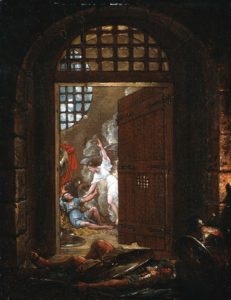“On the Kalendar” is a series examining some of the lesser known feast days on the Kalendar.

St. Peter Released from Prison, by Benjamin West (1738–1820). From Wikimedia.
Ellis Peters’ medieval detective series featuring Brother Cadfael takes place in Shrewsbury, where the abbey church is dedicated to Saint Peter and Saint Paul. (The two are commonly celebrated together as a political solution for not wanting to favor one saint over the other.) But the major fair held every year is the Saint Peter’s Fair commemorating Peter’s deliverance from prison, and the novel Saint Peter’s Fair begins shortly before the three–day festival.
The second feast is Lammas, which is more a pagan festival with a Christian veneer. Lammas celebrates the first harvest of grain, and has its origins in the cross-quarter day festival of Lughnasadh (prounounced “loo-na-sah”), held in honor of the ancient celtic god Lugh. The early British church appropriated the festival as a thanksgiving service, and the name Lammas is derived from the Anglo-Saxon hlaf-mas, “loaf mass, harvest festival”. (It’s likely that the festival being celebrated in Peters’ Saint Peter’s Fair is as much a Lammas festival as an observance of Saint Peter ad Vincula.)
Lammas loaves are often wreaths or plaits, but they can also be in the shape of a human figure (representing the god of the harvest), or in the shapes of animals.


